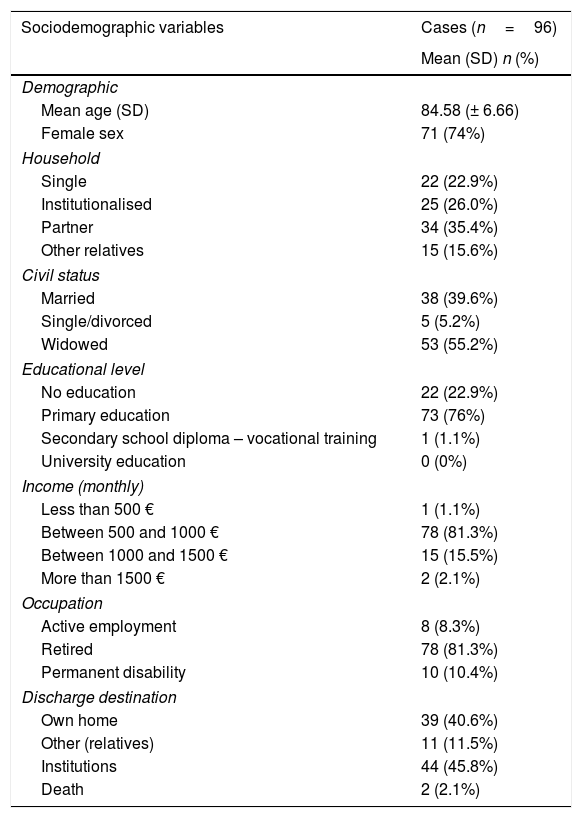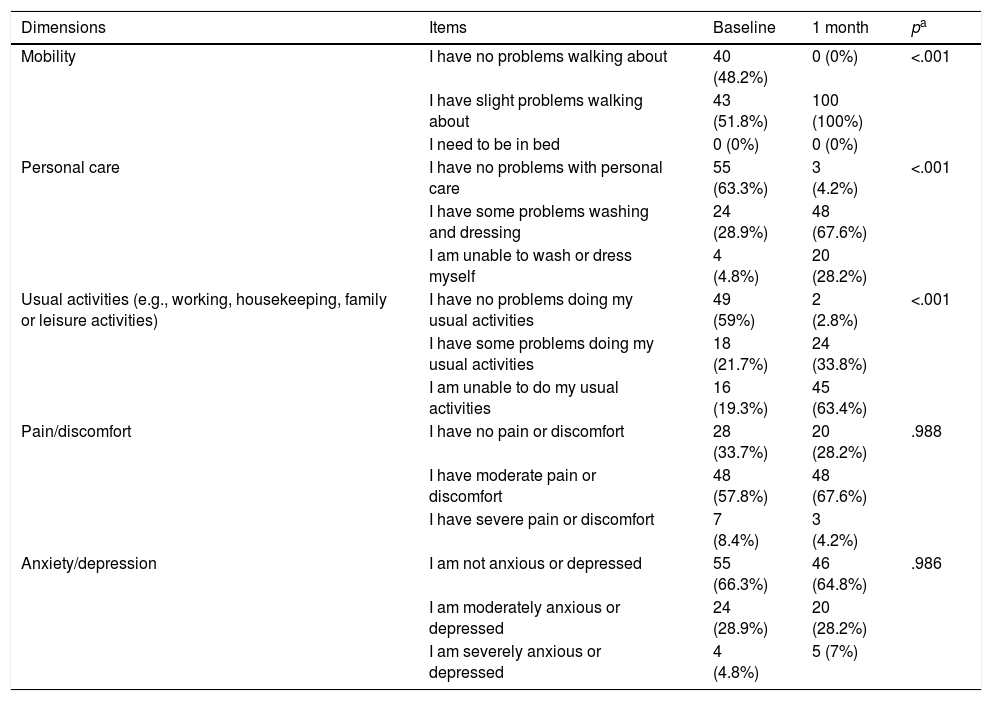To determine the quality of life related to health, functional capacity and mood to hip fracture and one month after surgery.
MethodProspective and descriptive study developed from January 2015 to January 2016 in Campo Arañuelo Hospital (Navalmoral de la Mata, Cáceres, Spain). Sociodemographic variables, functional capacity (Barthel Index), dependence (Lawton and Brody Scale), quality of life related to health (Questionnaire Euroqol-5D) and on mood (Yesavage geriatric depression scale GDS15) were collected, prior to the hip fracture and one month after the intervention.
ResultsSignificant decrease in functional capacity (Barthel), the mean score was 86.66 before the fracture, compared to 58.72 at the month after surgery (p<.001). Regarding the Lawton and Brody Scale, the mean was 4.95 and at 2.24months (p<.001). The mean scores on health related quality of life, baseline and post-intervention in the analogue visual scale of the EQ-5D questionnaire were 72.95 vs 59.45 respectively (p=.004). Although before the fracture, 94.10% had no alteration in mood, one month after the intervention there was a possible depression of 20.50% and an established depression of 11%.
ConclusionsThe fracture of the head affects the functionality of the elderly, causing dependence for the basic and instrumental activities of daily life. It also affects the quality of life related to health and this decreases significantly in the month after surgery. Depressive mood is inversely related to perceived quality of life.
Determinar la calidad de vida relacionada con la salud, la capacidad funcional y el estado de ánimo previo a la fractura de cadera y al mes de la intervención quirúrgica.
MétodoEstudio descriptivo prospectivo desarrollado desde enero de 2015 a enero de 2016 en el Hospital Campo Arañuelo (Navalmoral de la Mata, Cáceres). Se recogieron variables sociodemográficas, capacidad funcional (índice de Barthel), dependencia (escala de Lawton y Brody), calidad de vida relacionada con la salud (cuestionario Euroqol-5D) y estado de ánimo (escala de depresión geriátrica de Yesavage) con anterioridad a la fractura de cadera y al mes de la intervención.
ResultadosEn 96 pacientes mayores de 65años se produjo un descenso significativo de la capacidad funcional: la media fue de 86,66 antes de la fractura frente a 58,72 al mes de la intervención (p<0,001). La dependencia media fue de 4,95, y al mes, de 2,24 (p<0,001). Las puntuaciones medias sobre calidad de vida basal y posterior a la intervención en EQ-5D fue de 72,95 vs 59,45, respectivamente (p=0,004). Aunque antes de la fractura el 94,10% no tenían alteración del estado de ánimo, al mes de la intervención presentaban probable depresión el 20,50% y depresión establecida el 11%.
ConclusionesLa fractura de cadera afecta a la funcionalidad de los ancianos y provoca dependencia para las actividades básicas e instrumentales de la vida diaria. También afecta a la calidad de vida, y esta disminuye de forma significativa al mes de la intervención quirúrgica. El estado de ánimo depresivo está inversamente relacionado con la calidad de vida percibida.












